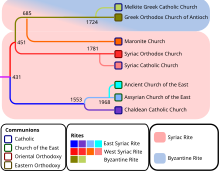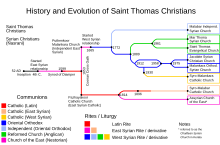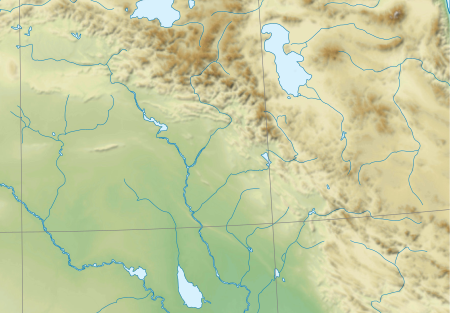lingvo.wikisort.org - LanguageBohtan Neo-Aramaic is a dialect of Northeastern Neo-Aramaic originally spoken by ethnic Assyrians on the plain of Bohtan in the Ottoman Empire. Its speakers were displaced during the Assyrian genocide in 1915 and settled in Gardabani, near Rustavi in Georgia, Göygöl and Ağstafa in Azerbaijan. However it is now spoken in Moscow, Krymsk and Novopavlosk, Russia. It is considered to be a dialect of Assyrian Neo-Aramaic since it is a northeastern Aramaic language and its speakers are ethnically Assyrians.
The closest related dialect is Hertevin, and Bohtan also shares many similarities with the peripheral Qaraqosh dialect.
Genealogy
This dialect is derived from the Northeastern Neo-Aramaic (NENA) languages, which is made up by Bohtan Neo-Aramaic, Assyrian Neo-Aramaic, Chaldean Neo-Aramaic, Hertevin, Senaya and Koy Sanjat Surat. Bohtan refers to the area between the Tigris and Bohtan river . The dialect mostly spoken by Christian communities.[3]
The Neo-Aramaic language is classified under Afroasiatic and the Bohtan dialect is more specifically one of the NENA dialects which are found south-eastern Turkey, northern Iraq and western Iran [4] Due to the dislocation of NENA speakers, neighboring languages have influenced the dialects, such as Kurdish.[5]
Phonology
Bohtan's consonant inventory is typical of other NENA dialects. Unlike Hertevin, it merges /ħ/ and /x/ into /x/.
Status
Bohtan Neo-Aramaic is considered as a severely endangered language as it is estimated to have less than 500 speakers, mostly found in the former Soviet Union. Due to migration and intermarriage, younger generations speak the language less fluently and are expected to know Russian or Turkish as their first language.[1]
See also
- Assyria
- Assyrian people
- Aramaic language
- Assyrian Church of the East
- Assyrian Neo-Aramaic
- Chaldean Neo-Aramaic
- Turoyo
- Syriac language
- Syriac alphabet
References
- Fox, S. 2009. The Neo-Aramaic dialect of Bohtan. New Jersey: Gorgias Press
- ethnologue
- Heinrichs, W. 1991: "Studies in Neo-Aramaic". Journal of the American Oriental Society 111, 191-192
- Khan, G. 2010. "The Debate on Ergativity in Neo-Aramaic" Proceedings of IATL
Further reading
- Heinrichs, Wolfhart. 1990. "Studies in Neo-Aramaic. Scholars Press: Atlanta, Georgia.ISBN 1-55540-430-8.
- Maclean, Arthur John. 1895: "Grammar of the dialects of vernacular Syriac: as spoken by the Eastern Syrians of Kurdistan, north-west Persia, and the Plain of Mosul: with notices of the vernacular of the Jews of Azerbaijan and of Zakhu near Mosul. Cambridge University Press: London.
- Greenfield, Jonas. 1978. “The Dialects of Early Aramaic". Journal of Near Eastern Studies, Colloquium on Aramaic Studies 37: 93-99
- Fox, Samuel. 2002. "A Neo-Aramaic Dialect of Bohtan", in W. Arnold and H. Bobzin, „Sprich doch mit deinen Knechten aramäisch, wir verstehen es!“ 60 Beiträge zur Semitistik Festschrift für Otto Jastrow zum 60. Geburtstag, Wiesbaden: Harrassowitz 165–180.
- Takashina, Yoshiyuki.1990. "Some Remarks on Modern Aramaic of Hertevin." Journal of Asian and African Studies 40: 85-132
- Jastrow, Otto. 1988. "Der neuaramäische Dialekt von Hertevin" (Provinz Siirt). Wiesbaden:L Harrassowitz.
- Fox, Samuel Ethan (2009). The Neo-Aramaic Dialect of Bohtan. Gorgias Press. ISBN 978-1-4632-1732-7.
External links
Modern Aramaic languages |
|---|
Red markers represent Christian Neo-Aramaic varieties while blue represents Jewish ones and purple represents both spoken in the same town. The map displays dialects of Northeastern Neo-Aramaic (both Jewish Neo-Aramaic and Christian Neo-Aramaic) as well as Turoyo and Mlahso, Central Neo-Aramaic varieties. The other branches of Neo-Aramaic are:
|
Syriac Christianity |
|---|
Eastern Christian traditions that employ Syriac language in their liturgical rites (with year of foundation in brackets) |
West Syriac, legacy of
the Patriarchate of Antioch | | Eastern Catholic |
- Maronite Church (410/685)
- Syriac Catholic Church (1662)
|
|---|
| Oriental Orthodox |
- Syriac Orthodox Church (518)
|
|---|
| Syriac Christianity Saint Thomas Christians Saint Thomas Christians |
|---|
East Syriac, legacy of
the Church of the East
(the "Nestorian Church")
(410–1552) | | Eastern Catholic |
- Chaldean Catholic Church (1552)
|
|---|
| Nestorian |
- Assyrian Church of the East (1692)
- Ancient Church of the East (1968)
|
|---|
| Protestant (Eastern Protestant) |
- Assyrian Evangelical Church (1870)
- Assyrian Pentecostal Church (1940)
|
|---|
|
|---|
Saint Thomas Christians,
legacy of
the Malankara Church
(active 1st century–1601)
in Kerala, India | | Eastern Catholic |
- Syro-Malabar Church (East Syriac) (1665)
- Syro-Malankara Catholic Church (West Syriac) (1932)
|
|---|
| Oriental Orthodox |
- Jacobite Syrian Christian Church (1665)
- Malankara Orthodox Syrian Church (1912)
- Malabar Independent Syrian Church (1772)
|
|---|
| Nestorian (Assyrian Church of the East) |
- Chaldean Syrian Church (1701)
|
|---|
| Protestant (Eastern Protestant) |
- Mar Thoma Syrian Church (1852)
- St. Thomas Evangelical Church of India (1961)
|
|---|
|
|---|
| Key figures |
- Jacob of Serugh
- Maron
- Nestorius
- Philoxenus of Mabbug
- Aphrahat
- Bar Hebraeus
- Dionysius bar Salibi
- Ephrem the Syrian
- Isaac of Nineveh
- Jacob Baradaeus
|
|---|
| Languages | |
|---|
| See also |
- Assyrian people/Syriac
- Assyrian nationalism
- Assyrian homeland
- Assyrian independence movement
- Proposals for Assyrian autonomy in Iraq
- Assyrian–Chaldean–Syriac diaspora
- Terms for Syriac Christians
- Malankara-Persian ecclesiastical relations
- Syriac sacral music
|
|---|
- * Defunct with schism of 1552
 Christianity portal Christianity portal
|
|
|---|
Caucasian
(areal) | | |
|---|
Indo-
European | |
|---|
| Turkic | |
|---|
| Others | |
|---|
- Italics indicate extinct languages
- Languages between parentheses are varieties of the language on their left.
- See also
- Languages of Armenia
- Languages of Azerbaijan
- Languages of Georgia
- Languages of Russia
|
Assyrian people |
|---|
Ethno-linguistic group(s) indigenous to the Middle East with various additional/alternate self-identifications, such as Syriacs, Arameans, or Chaldeans |
| Identity |
- Assyrian continuity
- Assyrian–Chaldean–Syriac diaspora
- Chaldean Catholics
- Terms for Syriac Christians
|  Assyrian flag  Aramean-Syriac flag  Chaldean flag Chaldean flag |
|---|
Syriac
Christianity | | West Syriac Rite |
- Syriac Orthodox Church (518–)
- Syriac Catholic Church (1662–)
- Assyrian Evangelical Church (1870–)
- Assyrian Pentecostal Church (1940–)
|
|---|
| East Syriac Rite |
- Chaldean Catholic Church (1552–)
- Assyrian Church of the East (1692–)
- Ancient Church of the East (1968–)
|
|---|
|
|---|
Aramaic/Syriac
languages | |
|---|
| Culture |
- Assyrian folk/pop music
- Music of Mesopotamia
- Syriac sacral music
- Folk dance
- Cuisine
- Clothing
|
|---|
History
(including
related
contexts) | | Ancient Assyria |
- Early Assyrian period (2600–2025 BCE)
- Old Assyrian period (2025–1364 BCE)
- Middle Assyrian Empire (1363–912 BCE)
- Neo-Assyrian Empire (911–609 BCE)
- Post-imperial Assyria (609 BCE–240 CE)
- Ancient Mesopotamian religion
- Arameans
- Assyrian tribes
|
|---|
Classical
antiquity |
- Seleucid Empire (312–63 BCE)
- Parthian Empire (247 BCE–224 CE)
- Osroene (132 BCE–244 CE)
- Syrian Wars (66 BCE–217 CE)
- Roman Syria (64 BCE–637 CE)
- Adiabene (15–116)
- Roman Assyria (116–118)
- Christianization (1st to 3rd c.)
- Nestorian schism (5th c.)
- Church of the East (410-1552)
- Asoristan (226–651)
- Byzantine–Sasanian wars (502–628)
|
|---|
| Middle ages |
- Muslim conquest of Mesopotamia (630s)
- Muslim conquest of Syria (630s)
- Abbasid Caliphate (750–1258)
- Emirs of Mosul (905–1383)
- Buyid amirate (945–1055)
- Principality of Antioch (1098–1268)
- Ilkhanate (1258–1335)
- Jalayirid Sultanate (1335–1432)
- Qara Qoyunlu (1375–1468)
- Aq Qoyunlu (1453–1501)
|
|---|
| Modern era |
- Safavid Empire (1508–55)
- Ottoman Empire (1555–1917)
- Schism of 1552 (16th c.)
- Massacres of Badr Khan (1840s)
- Massacres of Diyarbekir (1895)
- Rise of nationalism (19th c.)
- Adana massacre (1909)
- Assyrian genocide (1914–20)
- Independence movement (1919–)
- Simele massacre (1933)
- Post-Saddam Iraq (2003–)
- Genocide of Christians by ISIL (2014–)
|
|---|
|
|---|
| By country | Homeland
Settlements |
- Iraq
- Nineveh Plains
- Qaraqosh
- Alqosh
- Tel Keppe
- Bartella
- Ankawa
- Shaqlawa
- Zakho
- Iran
- Syria
- Turkey
|
|---|
| Diaspora |
- Armenia
- Australia
- Belgium
- Canada
- Finland
- France
- Georgia
- Germany
- Greece
- Israel
- Jordan
- Lebanon
- Mexico
- Netherlands
- New Zealand
- Russia
- Sweden
- United Kingdom
- United States
- Uruguay
|
|---|
|
|---|
| Politics |
- Assyrian Democratic Movement
- Assyrian Democratic Organisation
- Aramean Democratic Organization
- Assyrian Universal Alliance
- Dawronoye
- Syriac Union Party
- Syriac Military Council
- Sutoro
|
|---|
 History portal History portal Christianity portal Christianity portal
|
На других языках
[de] Bohtan-neuaramäische Sprache
Bohtan-Neuaramäisch ist eine moderne östliche neuaramäische Sprache. Sie wurde ursprünglich in der Ebene von Bohtan in der Provinz Şırnak in der Südost-Türkei gesprochen, heute jedoch vor allem in Südost-Georgien um das Dorf Gardabani nahe Rustavi herum.
- [en] Neo-Aramaic dialect of Bohtan
Текст в блоке "Читать" взят с сайта "Википедия" и доступен по лицензии Creative Commons Attribution-ShareAlike; в отдельных случаях могут действовать дополнительные условия.
Другой контент может иметь иную лицензию. Перед использованием материалов сайта WikiSort.org внимательно изучите правила лицензирования конкретных элементов наполнения сайта.
2019-2025
WikiSort.org - проект по пересортировке и дополнению контента Википедии






